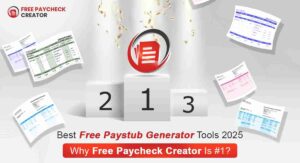6% to 13% of employees have pay issues every time they get paid. Most times, these turn into questions for the payroll team, and this causes big problems, more work, stress, and mess-ups.
It’s believed that a free paycheck stub maker can help in avoiding these challenges. This is absolutely true. In this guide, we will see five ways payroll calculations are done easily. So, let’s dive into it.
Need a Simple Way to Calculate Payroll?
Start using our Free Paycheck Stub Maker to generate accurate stubs in minutes.
What is a Payroll?
Payroll is simply the act of paying a company’s employees. It covers making a list of all the employees to be paid, keeping track of work hours, figuring out each employee’s pay, giving out pay on time, and noting down the payroll costs.
What are Payroll Calculations?
Payroll is defined as the amount a firm pays to its employees for the work done during a particular pay period. This includes their payments and more perks, which are taken when taxes are needed from their total pay.
Why are Payroll Calculations Important?
Payroll is key to a firm’s financial health. Wrong counts can lead to fines, legal problems, and harm the firm’s good reputation. It is vital to follow payroll rules to avoid high fines and penalties.
Also Read: Benefits of Free Payroll Check Generator for Employees
5 Ways Payroll Calculations are Done Using a Free Paycheck Stub Maker
The five ways in which payroll calculations are done are mentioned below:
1- Pay Periods:
Payroll calculations cover pay periods that cover a month or a week. A payroll cycle means a monthly, weekly, or bi-weekly payout to employees in exchange for their service. There are a few things to consider while defining pay periods:
- Governments require payroll reporting by financial years, which is then broken down into monthly, quarterly, half-yearly, and annual returns of different types.
- To simplify the process, the pay periods should correspond to the financial year.
- There should be a gap of 3-5 days between the end of the pay period and the payout date. This reduces pressure on the payroll processing department.
2- Salary Requirement:
There are different types of employees in your company, and it is helpful to define one or more salary structures for each employee.
A salary structure is a collection of information heads that includes:
- Wages
- Allowances such as house rent allowance, travel allowance
- Benefits such as retirement benefits, health insurance, like hospitals, and your company’s size
- Professional taxes
- Statutory bonus
- Gratuity, which is based on your company’s size
Employers need to use this information in various forms when sending legal work. There are other IDs, like ESI, that move the money cuts to the right employee files.
You can use the free paycheck creator to generate professional-looking paychecks for your business in no time.
Save Time with a Free Paycheck Creator
Generate professional paychecks instantly with our Free Paycheck Creator.
3- Types of Employees:
There are various types of salary components and tax rules for different employees. Therefore, you need to identify the employee types applicable to your firm. There are different kinds of employees covered, which include:
- Salaried
- Hourly
- Piece rate
- Consultants and Commission agents
4- Salary Calculation:
Salary Calculation deductions and exemptions make it rather complicated. After recognizing such deductions from payroll, this formula takes into account all elements like basic salary, allowances, deductions, and taxes for the employee to be paid fairly.
Since exact deductions, whether taxation or benefits, come under the radar of the employer, it is therefore necessary to define the basis on which salary would be computed and document the same along with other formalities. This can be shared with all employees; for example, it can be inserted as part of your company policies.
Most companies either use Leave without pay, or absence without Leave, to calculate salaries payable or days worked.
5- Employee Bank Information:
The check payments take longer to transfer to employees’ bank accounts which are inconvenient. Automatic bank transfers are the new normal for salary payments. Once setup is done, bank transfer is easier, faster, and has a lower cost.
Though employees might maintain an account with a bank that is different from the company’s bank account, it is vital to maintain bank transfer information for each employee.
By visiting free paycheck stub maker, you can take advantage of the free paycheck stub maker to generate pay stubs for your employees.
Also Read: Features of a Pay Stub
Instantly Generate Paystubs
Our Free Paystub Generator helps you create accurate paystubs quickly and easily.
FAQs
1- What are the main elements of payroll calculations?
Main elements of payroll calculations include gross salary, allowances, and deductions, all of which are vital information for accurate compensation calculations.
2- What is the formula for calculating payroll?
In order to calculate payroll, you should determine each employee’s gross pay by adding their earnings and any bonuses, minus the taxes and deductions, and then calculate the net income.
3- What are the two main components of payroll?
The two main components for payroll are: Separation of duties and the Approval procedure. Separation of duties ensures that no single person has full control over all the aspects of payroll, which shall reduce the risk of unauthorized actions.
4- What is the payroll process?
Payroll processing is necessary for employees to receive their pay. It has three stages where various tasks must be completed. The main tasks in the process include calculating total earnings, withholding and filing payroll taxes, and issuing the payments.
5- Are free paycheck stub maker really free?
Yes! Several online platforms offer a free paycheck stub maker for both employers and self-employed individuals. Examples include Online pay stubs, pay stub generators, and payroll check generator. Most of these services require only your payroll details and can provide results instantly without requiring you to sign up.
Key Takeaways
Timely payroll processing is a tough job. However, suppose you communicate the steps clearly and follow them carefully, and use a free paycheck stub maker for business. In that case, your payroll processing team can see a significant reduction in their workload.







